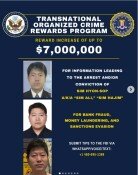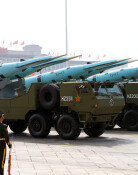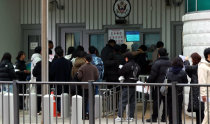Kim Jong Un threatens ‘Fight against Enemy’
Kim Jong Un threatens ‘Fight against Enemy’
Posted June. 13, 2022 07:53,
Updated June. 13, 2022 07:53
In the expanded plenary meeting of the Workers’ Party of Korea presided by President of the State of Commission of Democratic People’s Republic of Korea (DPRK) Kim Jong Un on Saturday, the phrase “Fight against the enemy” was mentioned targeting South Korea. President Kim Jong Un clarified “The principle of power against power (Gangdaegang) of head-to-head match” and proposed “militant initiatives” in the military force and national defense areas. He also progressed with the forward personnel transfers of the hard-liners against the United States and South Korea such as appointing Choe Son Hui, the former First Vice Minister of Foreign Affairs as the Minister of Foreign Affairs and Ri Son Gwon, the former Foreign Minister as the Chairman of the Committee for the Peaceful Reunification of the Fatherland.
North Korea’s coming up with the expression “Fight against the enemy” in two years means that it has the intention to push forward strong external policies of technically defining South Korea as “Enemy.” With the seventh nuclear test button ready, North Korea has definitely pulled up the provocation level against South Korea and the United States. President Kim Jong Un did not explicitly mention the nuclear test however, it is possible that he may push ahead with the test when internal issues such as Covid-19 gets settled down. North Korea already launched 18 missiles this year. The military tension on the Korean Peninsular creeps up as it is inevitable for the “Power against power” policy to run into a conflict.
Such strong stance held by North Korea is backfiring to the country by accelerating the tighter relationship among the United States, Japan and South Korea. The defense ministers of the three countries committed to conduct trilateral missile warnings and ballistic missile search and tracking exercises in the Singapore Asia Security Summit (ASS) (better known as Shangri-La Dialogue). Such exercises are in principle held once every quarter, but the aim is to put in place the suspended exercises since 2018. The U.S. and Korean Defense Ministers held a separate bilateral meeting and discussed provision of a swift deterrence by the United States in the event of North Korean nuclear test and also agreed upon expanding the joint exercises in the second half the year. This is a warning that no eyes are going to be closed against DPRK threats.
It is not the best plan to maintain tough stance against the military provocation. However, it is necessary to demonstrate that prices need to be paid for the nuclear and missile tests which compromise the stability of the Korean Peninsula. The United States, Japan and South Korea must strengthen the military cooperation including trilateral joint exercises, which has been suspended since 2018. The scope of cooperation could be widened in possible areas of counter-terrorism exercises, and humanitarian emergency preparedness trainings. The discussion should speed up on making Extended Deterrence Strategy and Consultation Group (EDSCG) concrete. The attempt to engage in dialogues with North Korea and the diplomatic collaboration efforts with China on blocking nuclear tests should also continue in parallel.





![[오늘과 내일/우경임]교육부 장관인가, 교사부 장관인가](https://dimg.donga.com/c/138/175/90/1/wps/NEWS/IMAGE/2025/12/26/133045801.1.png)

